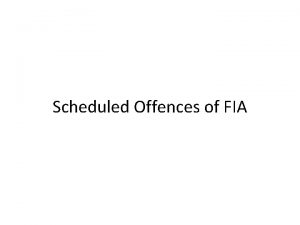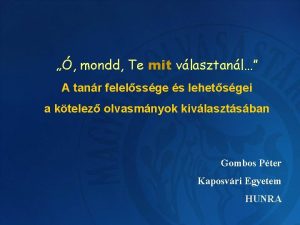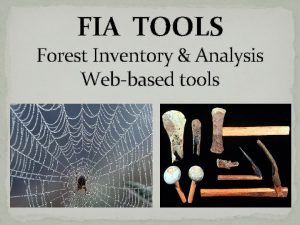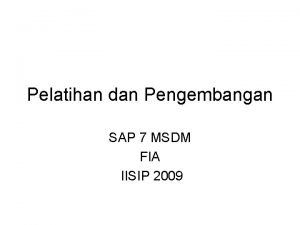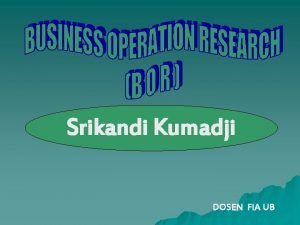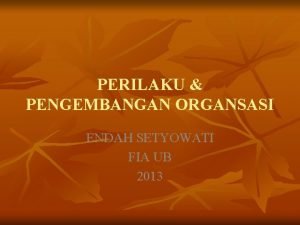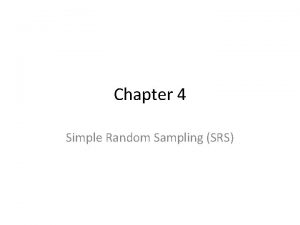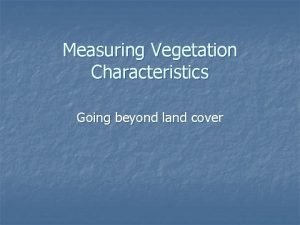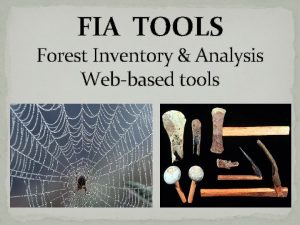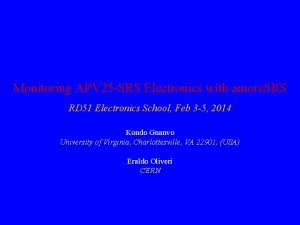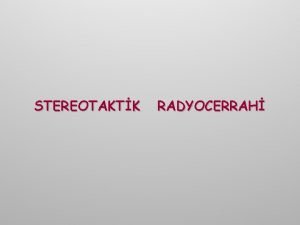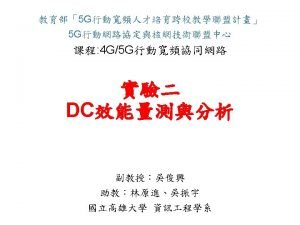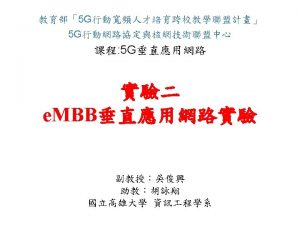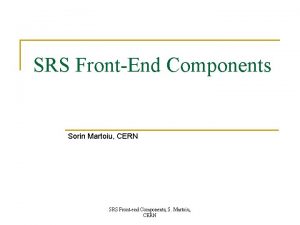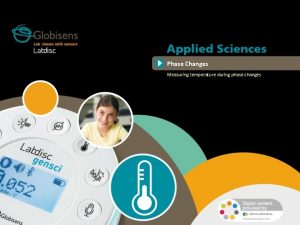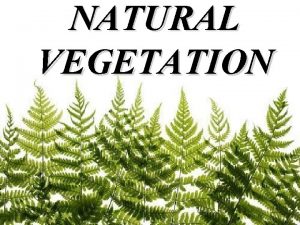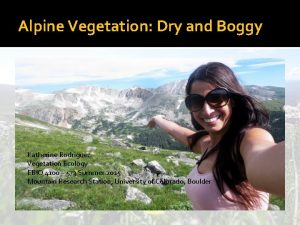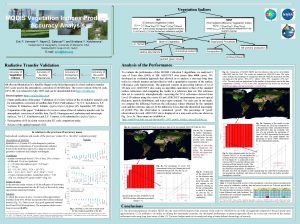SRS FIA Phase 3 Measuring Vegetation Diversity and






















- Slides: 22

SRS - FIA Phase 3 Measuring Vegetation Diversity and Structure in the Southern Region Sharon King Dept. of Forestry, Wildlife and Fisheries, University of TN in Cooperation with the USDA, Forest Service, Southern Research Station (Cooperative Agreement # SRS-02 -CR-11330145 -055)

Measuring Vegetation Diversity and Structure in the Southern Region This presentation was given at the 2002 State FIA Coordinators Meeting held in St. Augustine, FL October 9 and 10, 2002. This presentation is intended to introduce the State Coordinators to the P 3 Vegetation Diversity and Structure indicator program. Results presented here are PRELIMINARY and only based on subsets of data gathered in the SC pilot study. For updated information, please contact Sharon King at 865 -862 -2044 or sharonking@fs. fed. us This work is funded by USFS Cooperative Agreement number SRS-02 -CR-11330145 -055.

What Is the P 3 Vegetation Diversity and Structure Indicator? The measurement of species composition and vegetation structure of vascular plants on Phase 3 subplots Includes all trees, shrubs, herbs, grasses, ferns, and fern allies (horsetails and club mosses)

Objectives of the Program l To assess forest health in terms of structure, diversity, abundance and rates of change of vascular plant species l Particular interest in the following contexts: native vs. non-native species wildlife values wildland prescribed fires

South Carolina P 3 Vegetation Indicator Pilot Study l Objective: To evaluate the effort and costs associated with collecting all vegetation indicator variables on P 3 plots for the state of SC l South Carolina had 32 P 3 plots evaluated l Methods were those described in the March 2002 National Field Manual

Questions We Hoped to Answer From the SC Pilot Study l What kind of effort (botanist hours) is required to collect the data in the field using the outlined methods? l What is the best configuration for data sheets? l How much information is gained by each successive quadrat and subplot?

More Questions. . . l Are the variable measures sound and repeatable? l What kind of effort is required to document and identify unknown species? l What kind of effort is required to manage the data? l How does the Southern Region fit into the national program?

Pilot Study Timeline l April: Training in Macon, GA with Beth Schulz, National Indicator Advisor l May/June: Started the field season with 3 trips to SC; collected data from 4 plots – First plot done together – Other plots blind checked l June 18: Botanist started solo work with State P 3 crew l September 17: Field work completed l October 1: Data turned into SC on 21 plots, 11 still being processed

Vegetation Indicator Field Methods l Every plot contains four P 3 subplots l Subplot = 24 ft radius circle l Every subplot contains three 1 -m 2 quadrats at 30 o, 150 o and 270 o

Quadrat Measures (1 m 2 frame) l Cover of ground variables in quadrats to 1% l Cover of all species in, or overhanging quadrat (up to 6 ft) to 1% 6 ft.

This quadrat contained 9 species

Subplot Measures (24 ft. radius circle) l Identify all additional species on subplot and estimate cover to 1% Plot Center This subplot contained 33 additional species, 46 total

More Subplot Measures l For every species, layer of greatest foliage cover is recorded l For all four layer classes, total cover (of all species combined) is estimated to 1% Layer Classes 0 -2 ft. 2 -6 ft. 6 -16 ft. 16+ ft. Example Vaccineum tenellum : Quadrat 3: 37% Subplot: 10% Layer: 1 (0 -2 ft. ) Total Cover (all spp. ) in layer 1 (0 -2 ft): 64%

16+ ft. 6 -16 ft. 2 -6 ft. 0 -2 ft.

Dealing With Unknown Species l Species not known in the field are collected, tagged and bagged l All unknowns are assigned a number l Specimens are keyed, or logged and pressed l Protocol states that pressed unknowns are sent in to a herbarium for identification

Preliminary Study Results (Logistical) l Collected data on 32 Plots across state l Completed 72 out of 128 subplots (56%) l 115 hours spent on plot (Based on a subset of the data, does not include travel, locating plots, set-up, or any follow-up work off plot)

Preliminary Study Results (Biological) (From analysis of 10 plots, 26 subplots) l Total number of “species”: 353 l Ave. species per quadrat: 7 [3 -15] l Ave. species per subplot: 38 [14 -78] l Average unknowns/subplot: 9 [0 -35] l Completed plots: 1 unknown/subplot l Estimate 75 -130 unknowns for season once processed

Time in the Field (per subplot) (From analysis of 9 plots, 21 subplots) Time to complete subplot ~ 1: 36 l Quadrats: 24 min. l SP Search, T&B: 33 min. l Cover & Layer: 21 min. l Overall Layers: 4 min. l Miscellaneous: 14 min. ** Numbers do not reflect time to find or mark off plot Note: Analysis not complete!

Actual Time Spent on All Tasks (Projected from analysis of a subset of data) Time to complete pilot ~ 398 hours l Field time = 115 hrs l Plot set up = 32 hrs l Travel = 114 hrs l Specimens/data sheet clean-up = 115 hrs l Entry into Na. Tally = 22 hrs Note: Analysis not complete!

Summary l ~ 398 hours to complete 56% of subplots in state l Estimate ~ 616 hrs to complete all subplots (15. 5 wks @ 40 hrs/wk) l Practically equal amounts of time needed for travel, data collection, and data management l To implement region-wide we will need qualified botanists with specialized skills l May need to be creative with funding and logistics on a state by state basis

What’s Next From Here? l Compile complete data set from pilot and determine resource needs for region-wide implementation l Communicate with other regions to compare our experiences and share information l Evaluate goals, study methods, personnel and funding resources/needs to plan for implementation of the Vegetation Diversity and Structure Indicator program for all states in our region

Acknowledgements Byron Rominger Cindy Aulbach Beth Schulz SRS - FIA Univ. of TN, FWF
 Which phase transforms srs document into a form easily
Which phase transforms srs document into a form easily Genetic diversity vs species diversity
Genetic diversity vs species diversity Ecosystem jigsaw activity
Ecosystem jigsaw activity Fia
Fia Fia schedule offences
Fia schedule offences Laura titkos társasága
Laura titkos társasága Stanley, a szerencse fia
Stanley, a szerencse fia Zeusz testvérei
Zeusz testvérei Fia data mart
Fia data mart Istennek fia aki született
Istennek fia aki született Emese fia
Emese fia Popolano
Popolano Fia sap
Fia sap Fia consulting
Fia consulting Arész hadisten fia
Arész hadisten fia Dosen fia ub
Dosen fia ub Endah setyowati fia ub
Endah setyowati fia ub Mobile phase and stationary phase
Mobile phase and stationary phase Chromatography means
Chromatography means Adsorption chromatography
Adsorption chromatography Normal phase vs reverse phase chromatography
Normal phase vs reverse phase chromatography M tswett pronunciation
M tswett pronunciation Normal phase vs reverse phase chromatography
Normal phase vs reverse phase chromatography




